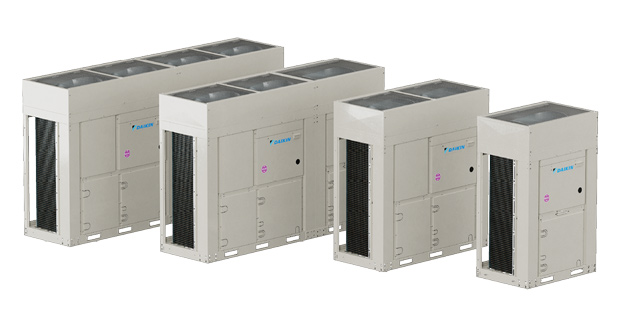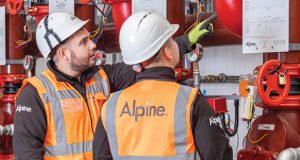 Steve Molloy, Sustainability & Commercial Solutions Manager at Daikin explains how heat pump technology can be used to meet the climate control needs of commercial buildings
Steve Molloy, Sustainability & Commercial Solutions Manager at Daikin explains how heat pump technology can be used to meet the climate control needs of commercial buildings
Non-domestic buildings currently account for 23 per cent of built environment carbon emissions and 66 per cent of this can be attributed to heating. This means that a switch from fossil fuels to renewable, low carbon climate control solutions, such as heat pumps, is essential for commercial buildings.
The first factor to consider when specifying a heat pump system is the heat sources available. For most projects in the UK, an air source heat pump (ASHP) will be the best solution due to a lack of access to suitable ground or water heat sources nearby. However, for those projects with the required body of water or appropriate geology close to the building, it may be possible to take advantage of the greater stability of water and ground temperatures to achieve more consistent year-round performance from the system.
Meeting space heating requirements is relatively simple for most commercial heat pump systems, especially for buildings with heating systems designed for lower temperatures. One of the main advantages of heat pumps over conventional heating systems is that heat pumps can be used to deliver comfort cooling requirements, as the refrigerant cycle can be reversed for cooling.
For projects where the heating and cooling requirements are more complex, there are multipurpose heat pump units that can efficiently achieve heating, cooling or a mixture of both, taking advantage of heat recovery. These ‘four pipe’ multipurpose heat pumps can provide an alternative to the gas burners used in central air handling units to treat the fresh air load, further reducing the building’s use of fossil fuels.
CRITICAL DESIGN CONSIDERATIONS
One factor that must be considered early in any project is the location and layout of the heat pump units. Commercial heat pump plant will occupy a significant amount of space, particularly as multiple units may be required to deliver the heating, cooling and DHW (domestic hot water) capacity. However, one factor that is sometimes overlooked when planning the most efficient use of a limited area is the spacing required between units. The cold air that is discharged from ASHPs will sink due to its lack of buoyancy. Without sufficient spacing between the units, there is a significant risk that the cold air will be recirculated through the heat pump, causing a loss of performance and capacity. Manufacturers will be able to provide guidance on ensuring there is adequate make-up of air and space between units to mitigate this issue.
Another important point for ASHPs is the impact that defrost cycles have on the capacity of units and how this can be managed. The ice that forms on the coils due to the low operating temperatures needs to be removed to maintain efficiency. Reversing the heat pump’s refrigerant cycle to deliver heat to the coil reduces the heating capacity by around 15 per cent and will impact the water temperatures within the system. Therefore, the system should be specified based on the ‘integrated capacity’, which is the capacity considering defrost, rather than the instantaneous or peak capacity.
For water and ground source heat pumps (GSHP), refrigerant safety is a particular issue that must be addressed when units are installed in a plant room. The risk of exposure to the refrigerant means that leak detection and emergency mechanical ventilation measures are required. There is also a need for fire risk assessments to be carried out as part of the design due to the classification of low global warming potential (GWP) and natural refrigerants as mildly flammable (A2L) or flammable (A3).
THE REGULATORY AND STANDARDS LANDSCAPE
There is an evolving number of environmental standards and regulations. The F-gas Regulation from the European Commission includes key measures such as reducing the number of hydrofluorocarbons (HFCs) which have GWPs thousands of times higher than that of CO₂, with more stringent changes expected from January 2026.
The industry can address HFCs without compromising efficiency and performance through refrigerants like R-32. This single-component refrigerant possesses a much lower GWP compared to commonly used refrigerants such as R-410A, while offering excellent thermodynamic properties that make it highly efficient in air conditioning and refrigeration systems.
Building standards such as BREEAM Version 7 now place a stronger emphasis on carbon reduction and climate resilience, with a growing focus on Environmental Product Declarations (EPDs). These provide detailed and verified data about the environmental impact of a product throughout its lifecycle. The UK Net Zero Carbon Buildings Standard provides a framework for achieving true net-zero carbon emissions, addressing both operational and embodied carbon.
PARTNERING FOR SUCCESS
Heat pumps have a vital role to play in the decarbonisation of buildings, which is essential if we are to meet climate targets. To ensure the best possible specification and design of a system that will meet the needs of occupants while reducing the carbon impact of heating, cooling and hot water, it is important to partner with the right supplier. A manufacturer who can offer a wide range of solutions will be able to deliver the best possible solution for any project and provide technical support, data-powered intelligence, and guidance throughout the entire process.





